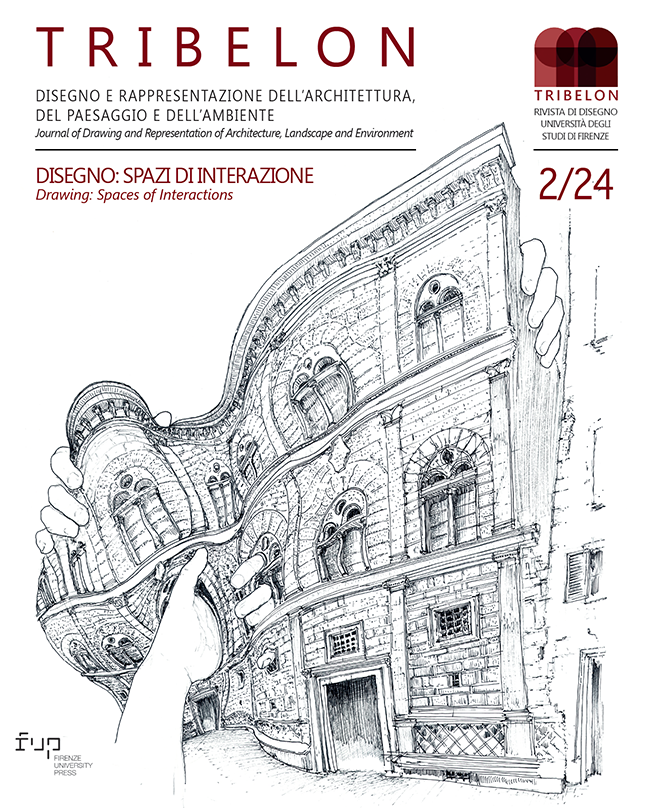Published 2024-12-19
Keywords
- Collaborative drawing,
- Cyberspace and cybertext,
- Integration and interaction,
- Hand drawing tools and applications,
- Automatic intelligence for drawing
How to Cite
Copyright (c) 2024 Maurizio Bocconcino

This work is licensed under a Creative Commons Attribution 4.0 International License.
Abstract
The concepts of cyberspace and cybertext are of pivotal importance in the understanding of urban environments and their representation. In the context of cyberspace, data and information are represented and manipulated in a virtual space, thereby creating new dimensions of interaction and perception. In these domains, drawing is the preferred medium for integrating disparate thematic worlds and facilitating interaction between individuals with different backgrounds, experiences and goals. The capacity to co-create these spaces, whether through adaptation or emulation of the model of the tangible world, or through the exploration of geometric and emotional liminalities disengaged from natural laws such as gravity, time, spatial and environmental geography, is the focus of this discussion, which takes its cue from the famous dialogue between Marco Polo and Kublai Khan in Italo Calvino's The Invisible Cities. The attitudes of the two are symmetrical: Marco's descriptions are characterised by wonder and curiosity, whereas Kublai's interpretations attempt to categorise them into a precise form through abstraction and generalisation. Marco is a professional traveller and an explorer of new concepts, whereas Kublai is sedentary and has the task of managing power and maintaining order. The objective of this contribution is to undertake a critical reflection on the systems of data, information and knowledge interchange that employ the design media as a site of interaction and integration of skills and visions, like the paradigmatic ones of Marco and Kublai, thereby participating in the structuring of complex virtual urban systems.
References
- A. Armando, Disegnare l’invisibile. Acquerelli di Alessandro Armando sulle Città invisibili di Italo Calvino, Mostra organizzata nell’ambito di Biennale Tecnologia (Tecnologia e Umanità), Torino 2024.
- A. Basu, A brief chronology of Virtual Reality, arXiv, 2019
- S. A. Bedini, Thomas Jefferson and His Copying Machines, University Press of Virginia, Charlottesville 1984.
- M. Bocconcino, Mappe “nd” che mostrano ciò che non si vede, per un’immaginazione del concreto - Sistemi informativi e prospettive future che già sono il presente, in S.Parrinello (a cura di) 3D BETHLEHEM Gestione e controllo della crescita urbana per lo sviluppo del patrimonio ed il miglioramento della vita nella città di Betlemme, Edifir Edizioni, Firenze 2022, pp. 166-183.
- M. Bocconcino, F. Ugliotti, Interattività e interoperabilità nel disegno a mano libera: alcuni approcci digitali a supporto della didattica | Interactivity and Interoperability in the Freehand Drawing: Digital Approaches Supporting Education, in A.Arena, M. Arena, D. Mediati, P. Raffa (a cura di) Connettere. Linguaggi, Distanze, Tecnologie Atti del 42° Convegno Internazionale dei Docenti delle Discipline della Rappresentazione / Connecting . Languages, Distances, Technologies. Proceedings of the 42nd International Conference of Representation Disciplines Teachers, Franco Angeli, Milano, 2020, pp. 119-138.
- B. Buxton, Some Milestones in Computer Input Devices: An Informal Timeline, Published, 18 febbraio 2011.
- I. Calvino, Le città invisibili, Einaudi, Torino 1972.
- I. Calvino, Italo Calvino on ‘Invisible Cities’, in Columbia: A Journal of Literature and Art, VIII, 1983, pp. 37-42.
- I. Calvino, Lezioni americane: sei proposte per il prossimo millennio (1988), Mondadori Editore, Milano 1993.
- D. Davidson, A Brief History of the Internet, in ACM SIGCOMM Computer Communication Review, XXXIX, 2009, 5, pp. 22-31.
- M. De Domenico, C. Marchese (a cura di), Mario Manganaro “...un disegnatore generoso”, Edas Editori, Messina 2018.
- M. Garber, The First Image of Earth Taken From Space (It's Not What You Think), in The Atlantic, 6 agosto 2012.
- I. Genuth, The Future of Electronic Paper. The Future Of Things, 2007.
- A. Grandelis, Il telescopio della letteratura. Gli scrittori italiani e la conquista dello spazio, Bompiani, Milano 2021.
- B. Leiner et al., A Brief History of the Internet, in Computer Communication Review, XXXIX, 1999, pp. 22-31.
- M. Prensky, Digital Natives, Digital Immigrants, in On the Horizon, MCB University Press, IX, 2001, 5.
- L. Rossi, Siamo solo all’1% del potenziale dell’intelligenza artificiale, è una rivoluzione epocale, intervista al Corriere della Sera, 29 ottobre 2024.
- Z. Tehseen, AlphaGeometry: l'intelligenza artificiale di DeepMind padroneggia i problemi di geometria a livelli olimpici, https://www.unite.ai/, 24 gennaio 2024.
- F. Van der Weel, A. Van der Meer, Handwriting but not typewriting leads to widespread brain connectivity: a high-density EEG study with implications for the classroom, in Front. Psychol. XIV, 2024.


